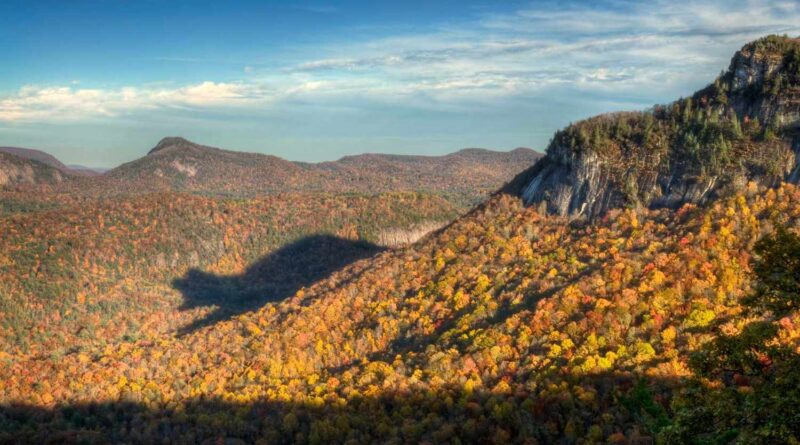The Shadow of the Bear Natural Phenomena in Cashiers North Carolina
Whiteside Mountain, located near Cashiers in western North Carolina, is one of the most beautiful and iconic peaks in the Blue Ridge Mountains. Rising to an elevation of 4,930 feet, it is renowned for its sheer cliffs, dramatic views, and unique rock formations. But beyond its geological wonders, Whiteside Mountain holds a seasonal natural phenomenon that draws visitors from across the country—the Shadow of the Bear.
The Shadow of the Bear is not just a stunning visual experience; it is a symbol of the region’s natural beauty, an event that celebrates the interaction between the landscape, light, and the changing seasons. This spectacular sight appears twice a year, in the fall and spring, offering a short window of time for nature enthusiasts, photographers, and curious travelers to witness the shadow cast by the mountain, resembling a giant bear stalking the valley below.
What Is the Shadow of the Bear?
The Shadow of the Bear is a natural shadow formation that occurs when the sun sets behind Whiteside Mountain, projecting a shadow that appears to be in the shape of a bear. As the sun dips lower in the sky, the shadow gradually grows in size until it clearly resembles a bear standing upright. The phenomenon lasts only about 30 minutes, making it a fleeting yet magical sight that attracts crowds to the base of Whiteside Mountain.
The bear-shaped shadow appears in a valley below the mountain, created by the unique combination of the mountain’s cliffs, the surrounding landscape, and the angle of the setting sun. While the shape of the shadow is partially due to the mountain’s jagged rocks, the silhouette is also influenced by trees and other natural elements in the foreground. This interplay creates a remarkably realistic bear shape, complete with a rounded head, body, and “legs.”
The Best Times to See the Shadow of the Bear
The Shadow of the Bear can be seen twice a year, during specific times of the fall and spring. Here’s when to plan your visit to see this natural marvel:
Fall Viewing: Mid-October to Early November
In the fall, the Shadow of the Bear can be viewed from mid-October to early November. During this period, the sun’s angle is just right to cast the bear-like shadow onto the valley floor below Whiteside Mountain. The autumn season is a particularly beautiful time to witness the phenomenon, as the surrounding foliage transforms into vibrant shades of red, orange, and yellow. The contrast between the fiery colors of the leaves and the dark silhouette of the bear creates a breathtaking scene that feels almost otherworldly.
Spring Viewing: Mid-February to Early March
The spring viewing season for the Shadow of the Bear occurs from mid-February to early March. During this time, the sun’s path shifts back to the correct angle to cast the bear shadow once again. The springtime version of the phenomenon often coincides with blooming wildflowers and fresh greenery in the valley, offering a different kind of beauty compared to the fall display. Though the trees have fewer leaves compared to the fall, the sight is equally mesmerizing, especially as the fresh spring air enhances the experience.
How to View the Shadow of the Bear
The best place to view the Shadow of the Bear is from Highway 64, also known as U.S. Route 64, which runs near the base of Whiteside Mountain. This vantage point offers an unobstructed view of the valley where the shadow appears. Here are some tips to help you make the most of your visit:
Timing Is Key
- Arrive early: The Shadow of the Bear begins to take shape about an hour before sunset, but it is best to arrive at least 30–45 minutes beforehand to secure a good viewing spot.
- Stay until sunset: The full silhouette becomes most distinct just as the sun reaches the horizon, so staying until the very end ensures that you see the complete transformation of the shadow.
- Check the weather: Clear skies are essential for seeing the shadow, so check the weather forecast beforehand. Clouds or fog can obscure the sun and disrupt the formation of the bear shape.
Bring the Right Gear
- Binoculars or a camera: Bring binoculars to get a closer view of the shadow as it forms, or use a camera with a good zoom lens to capture detailed photos of the phenomenon.
- Dress warmly: The temperature can drop rapidly as the sun sets, especially in the fall and early spring. Be sure to bring a warm jacket or sweater to stay comfortable while you wait for the shadow to appear.
Where to Park and Watch
- Parking: Parking is available along the roadside or at designated pull-off areas along Highway 64 near Whiteside Mountain. During peak viewing times, parking can be limited, so plan to arrive early.
- Viewing point: Find a clear spot with a good line of sight to the valley floor. Local guides and signs often indicate the best viewing areas for the Shadow of the Bear.
The Legend of the Shadow Bear
The Shadow of the Bear is not just a natural phenomenon; it has also become a part of local folklore. The Cherokee, who were the original inhabitants of the region, considered the bear a sacred animal and a symbol of strength, courage, and resilience. Some Cherokee legends speak of a giant bear that once roamed the mountains, with the shadow symbolizing its spirit returning each season.
The bear motif is common in Appalachian and Cherokee culture, often representing a guardian spirit of the mountains. For many locals and visitors, the Shadow of the Bear is seen as more than just a shadow—it’s a reminder of the mountain’s spiritual significance and a celebration of nature’s beauty. The phenomenon has become an emblem of the region, highlighting the close connection between the land and its cultural history.
Why the Shadow of the Bear Captivates Visitors
The Shadow of the Bear has grown in popularity over the years, becoming a must-see event for tourists, photographers, and nature lovers. Here’s why this phenomenon captivates so many visitors:
A Rare and Fleeting Beauty
The allure of the Shadow of the Bear lies in its brief, seasonal appearance. Because it can only be seen during specific times of the year and under the right conditions, witnessing it feels like a special privilege. The fact that the phenomenon is entirely natural—requiring no human intervention—adds to its mystique.
A Symbol of Nature’s Power
The Shadow of the Bear is a testament to nature’s ability to create stunning and unexpected displays. It’s a reminder of how natural forces like sunlight, terrain, and weather can combine to produce something magical. The phenomenon also represents the raw, unspoiled beauty of the Blue Ridge Mountains and their enduring connection to the natural world.
A Perfect Photography Opportunity
Photographers, both amateur and professional, are drawn to the Shadow of the Bear for its unique visual impact. Capturing the full formation of the bear shape, with the surrounding autumn colors or fresh spring greenery, is a rewarding challenge. Many visitors return each season to try to capture the phenomenon in different lighting conditions or against varied backgrounds.
Exploring Whiteside Mountain: More Than Just the Bear
While the Shadow of the Bear is a major draw, Whiteside Mountain offers much more for visitors to explore. Hiking trails wind up the mountain, offering breathtaking views of the surrounding valleys, forests, and the distant peaks of the Blue Ridge Mountains. The 2-mile loop trail to the summit provides panoramic vistas and glimpses of the rock faces that define the mountain’s rugged beauty.
The mountain is also home to a variety of wildlife, including black bears, deer, and many species of birds. For those who enjoy birdwatching, Whiteside Mountain offers the chance to spot peregrine falcons, one of the fastest birds in the world, which nest along the cliffs.
Planning Your Visit to the Shadow of the Bear
To make the most of your trip to see the Shadow of the Bear, consider the following tips:
- Visit during both viewing seasons: The fall and spring offer different scenic backdrops, making it worth visiting in both seasons to appreciate the full beauty of the phenomenon.
- Explore nearby attractions: Cashiers and nearby Highlands, NC, have plenty to offer in terms of dining, shopping, and exploring. Make a day trip or a weekend out of your visit to the region.
- Stay for sunset: Even if the shadow itself is fleeting, the sunsets at Whiteside Mountain are often spectacular, with vibrant colors illuminating the Blue Ridge horizon.
FAQs
What is the Shadow of the Bear at Whiteside Mountain?
It’s a natural shadow formation that resembles a bear, cast by the setting sun behind Whiteside Mountain in Cashiers, North Carolina.
When can you see the Shadow of the Bear?
The phenomenon can be seen twice a year: from mid-October to early November in the fall and mid-February to early March in the spring.
How long does the Shadow of the Bear last?
The bear-shaped shadow lasts about 30 minutes, appearing gradually as the sun sets and becoming most distinct just before sunset.
Where is the best place to view the Shadow of the Bear?
The best viewing point is along Highway 64 near the base of Whiteside Mountain, where you get a clear view of the valley where the shadow appears.
Is the Shadow of the Bear visible every day during its season?
It depends on the weather—clear skies are essential for seeing the shadow. Cloudy or foggy conditions can obscure the phenomenon.
What is the history behind the Shadow of the Bear?
The shadow is a natural event, but it has become part of local folklore, symbolizing the bear’s spiritual presence in Cherokee culture and Appalachian heritage.
Discover more from City Towner
Subscribe to get the latest posts sent to your email.




